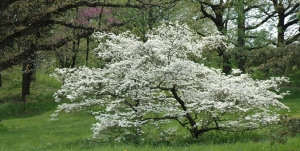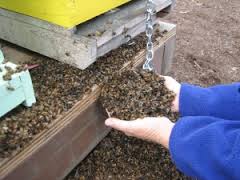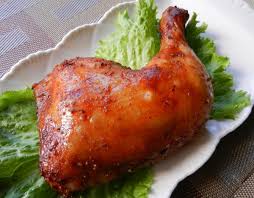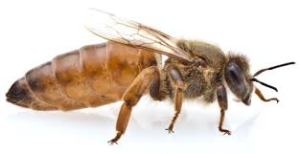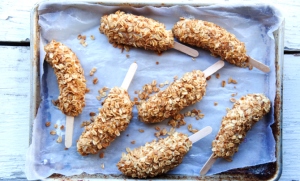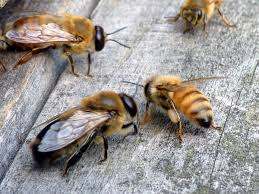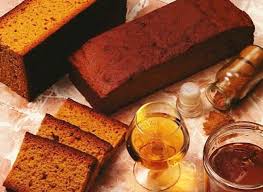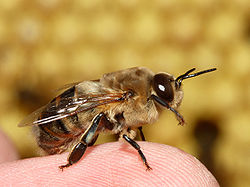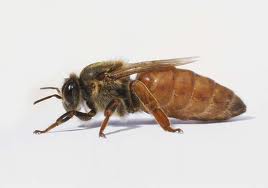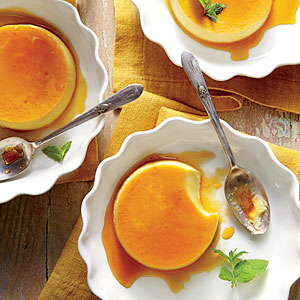First I want to congratulate Cedar and Stuart Anderson on their amazing Indiegogo campaign. It has been wild to watch and proves that crowdfunding works. I also wish you all the best in building and shipping all those bee hives to your thousands of funders. Bravo.
LIKE MOST OUTSPOKEN BEEKEEPERS, I have received 30+ links to the “FLOW HIVE” ads from family, loved ones and my blog fans. All sent with enthusiasm for the well-being of our beloved bees and each received with an element of skepticism. So before the next 30 arrive I’ve decided to break from my INDIEGOGO CAMPAIGN THEME of a DAILY BEE FACT / HONEY RECIPE to address the three main concerns which Natural Beekeepers share about THE FLOW HIVE.
(1) PLASTIC – THE FLOW HIVE relies on plastic comb foundation; it is not the first hive designed to utilize plastic comb foundation. In fact, within most beekeeping associations world-wide there is much debate over plastic foundation vs. commercial wax foundation vs. natural bees wax foundation. Each group demonstrates a strong argument in their favor and cites certain benefits for their bees.
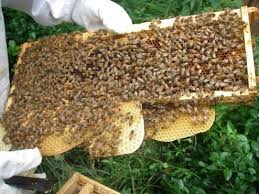
A frame of commercial bees wax with natural comb attached to the frame. NCSU
In 2013, I was asked to take care of four hives in Sylvan Park Community, Nashville, TN. Two hives had an interesting mix of plastic and wax foundation; the combination enabled me to observe firsthand what all natural beekeepers advocate. Given a choice, bees will choose wax over plastic. Left to their own devises, bees will build natural comb.
Hive comb is not simply a vehicle for honey, it is the living membrane of the hive charged with antibacterial enzymes that keep the queen, her brood and the entire colony healthy. Wax emerges from the thorax of 12 day old bees and is mixed with traces of propolis by chewing, then the softened wax is applied to the surface of the comb. I don’t believe this is a stage that can be easily edited from a new bee’s development or that wax production distracts bees from their work of collecting the “honey crop”. 12 day old bees are not adequately developed to forage for nectar; they are simply not ready, it’s like sending your 4 year old to the grocery store. Building wax comb is a developmental stage in each worker bee’s life and as such, I believe, this stage is of dire importance in developing strong, disease resistant bee colonies.
(2) HARVESTING HONEY- The second concern among natural beekeepers is the implied notion that honey harvesting kills bees and so adding a nozzle to the hive will save bees. Yes, some bees get squished when beekeepers open hives. However, in a colony of 30,000 to 60,000 bees an efficient beekeeper may only squish 3-6 bees and a genuinely sloppy beekeeper may kill 30 bees and get stung as many times.
When I harvested honey at our Bucksnort Sanctuary last year, I pulled the frames full of honey, hung them next to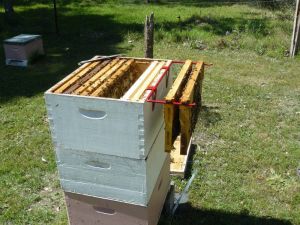 their hive and then went swimming until dusk. When I drove back to the apiary, the bees had returned to their hive and I loaded the frames full of honey into my SUV. There were a dozen lingering bees on as many frames of honey. Granted, I’m not a commercial beekeeper; but removing bees with a quick shake of the frame or blowing bees off the frames with a commercial blower is not responsible for the demise of bees…. Pesticides are killing the bees.
their hive and then went swimming until dusk. When I drove back to the apiary, the bees had returned to their hive and I loaded the frames full of honey into my SUV. There were a dozen lingering bees on as many frames of honey. Granted, I’m not a commercial beekeeper; but removing bees with a quick shake of the frame or blowing bees off the frames with a commercial blower is not responsible for the demise of bees…. Pesticides are killing the bees.
(3) HONEY ON TAP– My genuine concern about honey on tap is the opportunity to harvest too much honey; thereby leaving an in adequate supply of honey for the bees. Leaving enough honey for the colony is not just an ongoing debate, it is a constant challenge for all beekeepers. Weather, pests, intruders, disease all plague the modern beekeeper, but starvation breaks a beekeeper’s heart every time.
There is nothing sadder than seeing dead bees head down in the comb trying to find one more drop of honey. In my opinion, the FLOW HIVE in the hands of amateur beekeepers removes the one remaining barrier that often protects bees from inexperience, “the sheer intimidation of the harvest”. How could anyone resist the temptation to crack that tap open for the first harvest and how would any new beekeeper realize what is too much honey when you can’t see the result.
Nationally acclaimed Natural Beekeeper Ross Conrad says it best, “The health of a hive is the sum total of a wide variety of large and small details. Such a state of health can be accomplished consistently not by approaching the craft of beekeeping though an industrial, one-size-fits-all model, but only by recognizing and respecting apiculture as the natural biological activity that it is.” And these are the points of contention between Natural Beekeepers and FLOW HIVE with it’s plastic foundation.


